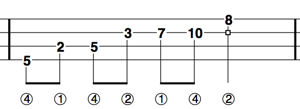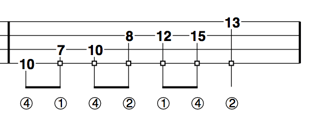Learning how to play your arpeggios all the way up the neck of your instrument is one of the best things you can do to improve your playing on any instrument. Some teachers even recommend learning your arpeggios before your scales. I personally recommend learning your major scale, then learn all of your arpeggios, and then go back and learn all of your other scales such as minor, pentatonic, etc.
An arpeggio is simply a chord one note at a time. In a major triad chord such as a C major, there are 3 notes. These notes consist of the root (C), the third (E), and the fifth (G) degree of the scale. When you play a chord you are playing all of these notes together at the same time. When you play an arpeggio, you are playing them one by one. So in the C major example, you would play a C note, then an E note, and then a G note. This would be a C major arpeggio.
 |
| C major arpeggio |
After you can play this C arpeggio, I would then suggest you learn how to play this arpeggio in multiple octaves. You would play C, E, G, then the next highest C note, and keep going up from there to the E, G, C, etc. First start by learning these with open strings. Next you want to learn how to play these without using any open strings. When you do the multiple octaves, you really want to focus on how you are making your position changes on the neck of the banjo.
Below you can see how to play 2 octaves of an F major arpeggio on the tenor banjo without using any open strings.
 |
| 2 octaves of an F major arpeggio |
Notice the position shift after you play the 3rd fret on the string. Pay close attention to using the correct left hand fingering (marked under the note).
Below is 2 octaves of a Bb major arpeggio. Notice how it uses the same fingering as the F arpeggio.
 |
| 2 octaves of a Bb major arpeggio |
I would suggest starting here and learning all 12 major triad arpeggios. Try to at least do 2 octaves. If you can do more, keep going!
After you finish your major triad arpeggios, learn your minor triad arpeggios. Then learn dominant 7 arpeggios, minor 7th arpegios, diminised arpeggios, etc.
It doesn't matter what style of banjo playing you do, creating a warmup routine for yourself each time you pick up your banjo will help you progress and...
Every banjo player dreams of a signature sound, a style that sets them apart and instantly captivates listeners. It's the difference between mimicking your...
One of the biggest myths about the banjo is that it is hard to play. After generations of blisteringly fast bluegrass licks dominating the public's perception...
"Can you play clawhammer banjo on a resonator banjo?" It's a question that comes up fairly often both on online forums and out in the public. The answer is...
3733 Kenora Dr.
Spring Valley, CA 91977
COMMENTS